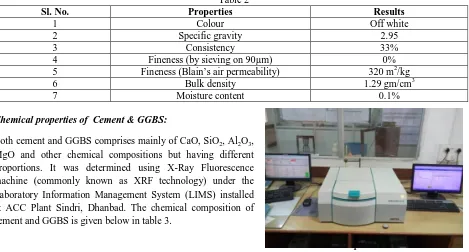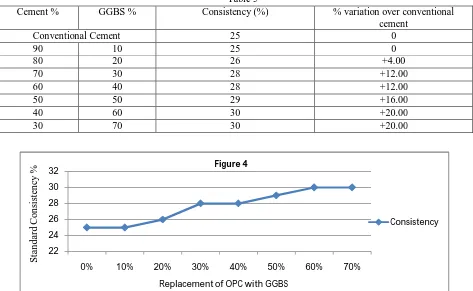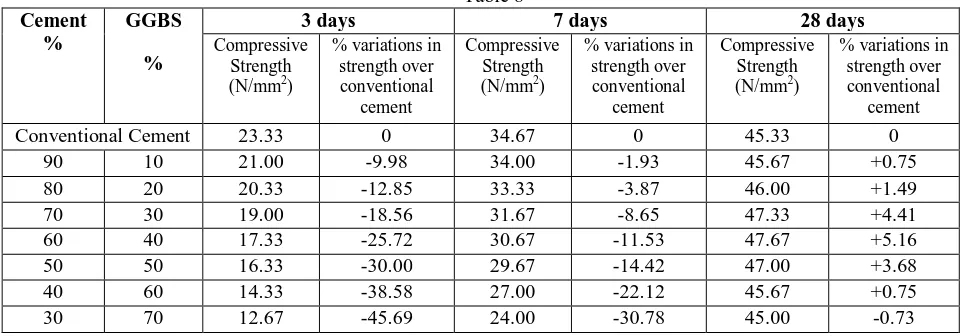Assessment of the Properties of Cement &
Mortar using GGBS
Ishwar Chandra Thakur1, Prof. Sheo Kumar2, Prof. J.P.Singh3
M.Tech. Scholar, Structural Engineering, Civil Engg. Dept., BIT Sindri, Dhanbad, Jharkhand, India1
Associate Professor, Civil Engg. Dept., BIT Sindri, Dhanbad, Jharkhand, India2,3
ABSTRACT: Mortar is the material used in masonry construction to fill the gaps between the bricks and blocks used in construction. Mortar is a mixture of fine aggregate, cement & water and applied as a paste which then sets hard. It is very clear that among the all components, fine aggregate and water is largely available material in India at very low cost. As cement is comparatively high cost it would be advisable to use other locally available industrial and agricultural waste material to replace the cement partially. Ground Granulated Blast-furnace Slag (GGBS), a non-metallic and non-hazardous waste material from Iron Industry, is suitable for mortar mix and enhanced properties of mortar like compressive strength, reduce the drying shrinkage, heat of hydration and retards the setting time of cement etc. The main objective of this research work is to determine the optimum content of GGBS which can be suitably used under the Indian conditions. To fulfill this objective various properties of concrete using GGBS have been studied.
KEYWORDS: GGBS, cement, fine aggregate and mortar
I. INTRODUCTION
The concrete industry is constantly looking for supplementary cementitious material with the objective of reducing the solid waste disposal problem and cost of material. Ground granulated blast furnace slag (GGBS), Fly Ash (FA), Rice husk ash (RHA), Quarry sand (QS) etc. are among the solid wastes generated by various industries. Substantial energy and cost savings can result when these industrial by-products will be used as partial replacements for the energy- intensive Portland cement. This investigation attempts to study the feasibility of using locally available GGBS as partial replacements for cement. It is obtained from iron manufacturing industries.The main component of blast furnace slag are CaO (30-50%), SiO2 (30-40%), Al2O3 (8 -24%) and MgO (1-18%) which is close to the chemical composition of Portland cement.
Ground granulated blast-furnace slag (GGBS) is commonly used in combination with portland cement in concrete and mortar for many applications [1,13,16]. Concrete and mortar made with GGBS has many advantages, including improved strength, durability, workability economic and environmental benefits [1]. The drawback in the use of GGBS concrete is that its strength development is considerably slower under the standard curing conditions than that of portland cement concrete, although the ultimate strength is higher for the same water–cementitious ratio[3,4,14,15,17,18]. The major factors affecting the early age strength development of concrete and masonry are:
Concrete mixture composition, including factors such as water–binder ratio and the type of supplementary
cementitious materials like ggbs,
type of formwork and size of structural element, and
environmental conditions.
In order to investigate the effect of strength development of portland cement in combination with GGBS, mortars have been prepared with varying percentage of GGBS ( 0%, 10%, 20%, 30%, 40%, 50%, 60% and 70%)
Therefore, the experimental program has been undertaken with the following objectives:
To check the variation of consistency of cement at different percentage of GGBS.
To observe the variation of initial setting & final setting time of cement at different percentage of GGBS.
II. JUSTIFICATION OF PROBLEM
This research was performed in order to generate specific experimental data on the potential use of GGBS as a cement replacement in masonry and concrete works. Utilization of GGBS has the benefits of eliminating the costs of disposal, lowering the cost of cement production and reduction of carbon dioxide gas. This will lead to a greener environment.
III. PRODUCTION OF GGBS
During of the production of iron in a blastfurnace, iron ore and coke are heated to about 1500°C to 1600oC. Silicate and
aluminate impurities from ore and coke are combined with flux (either limestone or dolomite) which lowers the viscosity of slag. Resulting in the formation of two products namely- molten iron and molten slag. The molten slag is lighter and floats on the top of the molten iron. Molten iron is then tapped off, the remaining molten slag, which consists of mainly silicious and aluminious residue. The resulting molten slag involves cooling through high-pressure water jets. Slow cooling of slag results in the formation of unreactive crystalline material consisting of an assemblage of Ca-Al-Mg silicates. To obtain a good slag reactivity or hydraulicity, the molten slag needs to be rapidly cooled or quenched below 800 °C in order to prevent the crystallization of merwinite and melilite resulting in the formation of granular particles of diameter not more than 5 mm. The resulting granular material comprises some 95% non-crystalline calcium-alumino-silicates. Then the granulated slag, after drying, is ground to a very fine powder in the rotating ball mill, which contains some 3.6 million high chromium steel balls. The obtained grounded material is known as Ground Granulated Blastfurnace Slag (GGBS).
Figure 1: Blast furnace, source of GGBS Figure 2: Molten slag en route
IV. MATERIAL USED
1. Cement
Table 1
Sl. No. Properties Results Standard Limits
1 Colour Gray --
2 Standard Consistency 25% --
3 Soundness(By Le-Chatelier method) 4mm <10mm
4 Initial setting time 110 minutes >30 min
5 Final setting time 290 minutes <600 min
6 Specific gravity 3.13 3.15
7 Fineness (By sieving on 90µm) 8.5 % <10%
8 Fineness (Blain’s air permeability) 302 m2/kg >225 m2/kg
9 Bulk density 1.48 gm/cm3
10 Compressive strength
3days 7days 28 days
N/mm2
23.33 34.33 46.18
N/mm2
>23 >33 >43
2. GGBS
Ground Granulated Blast-furnace Slag (GGBS) used in this project is the mixed slag of Tata Steel, Jamshedpur and Electro Steel Chandankyari, Dhanbad which were collected from ACC Sindri Plant, Dhanbad, Jharkhand. The physical tests on GGBS were performed in Concrete Laboratory at B.I.T. Sindri. The results of which is given below in table 2.
Table 2
Sl. No. Properties Results
1 Colour Off white
2 Specific gravity 2.95
3 Consistency 33%
4 Fineness (by sieving on 90µm) 0%
5 Fineness (Blain’s air permeability) 320 m2/kg
6 Bulk density 1.29 gm/cm3
7 Moisture content 0.1%
Chemical properties of Cement & GGBS:
Both cement and GGBS comprises mainly of CaO, SiO2, Al2O3, MgO and other chemical compositions but having different proportions. It was determined using X-Ray Fluorescence machine (commonly known as XRF technology) under the Laboratory Information Management System (LIMS) installed at ACC Plant Sindri, Dhanbad. The chemical composition of cement and GGBS is given below in table 3.
F
Table 3
Sl. No. Chemical Composition Cement GGBS
1 CaO 63.20 35.27
2 SiO2 21.06 34.72
3 Al2O3 5.72 19.11
4 MgO 1.90 8.46
5 Fe2O3 4.38 0.5
6 SO3 2.04 0.18
7 Na2O 0.25 0.16
8 K2O 0.87 0.58
9 Cl 0.01 0.01
10 TiO2 0.40 0.65
11 P2O5 0.09 0.01
12 Mn2O3 0.07 0.14 (MnO)
13 Glass Content -- 95
Check for chemical composition of cement & GGBS:
Lime Saturation Factor (LSF) of cement = .
. . . = 0.90
As per IS: 8112-1989 the permissible value of LSF is between 0.66 to 1.02. The results shows that the value is within the permissible limit.
Ratio of alumina and iron oxide of cement = = 1.31
As per IS: 8112-1989 the permissible value of ratio AF should not be less than 0.66. The results shows that the value is within the permissible limit.
Hydraulic Index of GGBS = = 1.81
As per IS: 12089-1987 the value of Hydraulic Index should not be less than 1. The results shows that the value is within the permissible limit.
3. Fine aggregate
The fine aggregate used in this project is natural sand of Barakar River. The various properties have been performed as per the procedure laid down in IS: 2386 (Part I)-1963 and the result was checked as per IS: 383-1970.Various properties of fine aggregate as obtained is given below in table 4.
Table 4
Sl. No. Test Result
1 Zone II
2 Free (surface) moisture 0.60%
3 Water Absorption 1.10%
4 Fineness Modulus 2.78
5 Specific gravity 2.62
6 Unit weight(Compact) 1.63gm/cc
The results obtained by incorporation of GGBS in OPC 43 gade is presented in the following paragraphs. Here we performed the tests by varying the GGBS from 0 to 70% keeping the weight of cementitious material (cement & GGBS) constant.
(1)
Standard Consistency of (cement +GGBS)The standard consistency of a cement with varying percentage of GGBS was performed with the help of Vicat apparatus attached with plunger (as explained in IS: 5513- l996) in accordance with IS: 4031(Part IV) - 1996. The result obtained is summerized in table 5 below and graph showing its variation is presented in figure 4.
Table 5
Cement % GGBS % Consistency (%) % variation over conventional
cement
Conventional Cement 25 0
90 10 25 0
80 20 26 +4.00
70 30 28 +12.00
60 40 28 +12.00
50 50 29 +16.00
40 60 30 +20.00
30 70 30 +20.00
From the above fig., it is observed that the standard consistency of OPC increases by incorporation of GGBS. This is because of the fineness of cement increases as the content of GGBS increases. Which means that an extra amount of water required for having equal consistency of cement paste made up with finer cement. It is increases from 0 to 20% when GGBS increases from 10 to 70%.
(2)
IST & FST of (cement +GGBS)Initial Setting Time and Final Setting Time of a cement with varying percentage of GGBS was performed with the help of Vicat apparatus attached with needle (as explained in IS: 5513- l996) in accordance with IS: 4031(Part V) - 1996. The result obtained is summerized in table 6 below and bar chart showing its variation is presented in figure 5.
22 24 26 28 30 32
0% 10% 20% 30% 40% 50% 60% 70%
S
ta
n
da
rd
Co
n
si
st
en
cy
%
Replacement of OPC with GGBS Figure 4
Table 6
Cement % GGBS % IST FST
Time in minutes
% variation over conventional cement
Time in minutes
% variation over conventional cement
Conventional Cement 110 0 290 0
90 10 135 +22.73 300 +3.44
80 20 155 +40.91 305 +5.17
70 30 180 +63.64 320 +10.34
60 40 230 +109.09 325 +12.07
50 50 255 +131.82 355 +22.41
40 60 280 +154.55 365 +25.86
30 70 320 +190.90 380 +31.03
From table 6, it is observed that IST & FST increases by the incorporation of GGBS in cement. Rate of increment of IST is greater than that of FST. This increase in setting time indicates that the addition of GGBS retards the initial hydration of cement. From above graph it is clear that, at 40% replacement level IST increases by 109.09% where as FST increases by 12.07% only. The variation of which is shown in figure 5 below.
(3)
Soundness of (cement +GGBS)Soundness test is done to ensures that the cement after setting shall not undergo any appreciable change of volume. This test was performed using Le-Chatelier apparatus as per IS: 4031(Part III) - 1996. The result obtained is summerized in table 7 below and graph showing its variation is presented in figure 6.
Table 7
Cement % GGBS % Soundness (mm) % variation over conventional cement
Conventional cement 4 0
90 10 4 0
80 20 4 0
70 30 3.5 -12.50
60 40 3.5 -12.50
50 50 3 -25.00
40 60 2 -50.00
30 70 2 -50.00
0 100 200 300 400
0% 10% 20% 30% 40% 50% 60% 70%
Ti
m
e
(m
in
u
te
s)
Replacement of OPC with GGBS Figure 5
IST
(4)
Compressive Strength of (cement +GGBS) mortarCompressive strength test of cement was determined by testing a cube of size 70.6mm in Universal Testing Machine at
uniform rate of loading starting from zero to 35 N/mm2/min as per IS: 4031(Part VI) - 1988. The cube made up with
mortar of standard sand and cement and water. The standard sand was prepared as per IS: 650 -1991. The result obtained is summerized in table 8 and graph showing its variation is presented in figure 7.
Table 8
Cement %
GGBS
%
3 days 7 days 28 days
Compressive Strength (N/mm2)
% variations in strength over conventional cement
Compressive Strength (N/mm2)
% variations in strength over conventional cement
Compressive Strength (N/mm2)
% variations in strength over conventional cement
Conventional Cement 23.33 0 34.67 0 45.33 0
90 10 21.00 -9.98 34.00 -1.93 45.67 +0.75
80 20 20.33 -12.85 33.33 -3.87 46.00 +1.49
70 30 19.00 -18.56 31.67 -8.65 47.33 +4.41
60 40 17.33 -25.72 30.67 -11.53 47.67 +5.16
50 50 16.33 -30.00 29.67 -14.42 47.00 +3.68
40 60 14.33 -38.58 27.00 -22.12 45.67 +0.75
30 70 12.67 -45.69 24.00 -30.78 45.00 -0.73
From above table 8, it is observed that compressive strength of mortar of partially replaced OPC with GGBS decreases at 3days and 7days while at 28 days it is increases giving the optimum at 40%. It indicates the slower rate of reaction of matrix by incorporation of GGBS. At 40% replacement level the compressive strength is 5.16% higher than that of conventional cement mortar. The variation of which is shown in figure 7 below.
0 1 2 3 4 5
0% 10% 20% 30% 40% 50% 60% 70%
So u n d n es s (m m )
Replacement of OPC with GGBS Figure 6 Soundness 0 10 20 30 40 50
0% 10% 20% 30% 40% 50% 60% 70%
C o m p re ss ive s tr en gt h (N /m m 2)
Replacement of OPC with GGBS Figure 7
3 days
7 days
VI. CONCLUSION
On the basis of results obtained in this study, the following conclusion has been made:
Standard consistency of OPC increases by incorporation of GGBS. This is because of the fineness of cement
increases as the content of GGBS increases. This means that an extra amount of water required for having equal consistency of cement paste made up with finer cement. It is increases from 0 to 20% when GGBS increases from 10 to 70%.
IST & FST increases by the incorporation of GGBS in cement. Rate of increment of IST is greater than that of
FST. This increase in setting time indicates that the addition of GGBS retards the initial hydration of cement. Particularly, at 40% replacement level IST increases by 109.09% where as FST increases by 12.07% only.
Soundness of partially replaced OPC with GGBS decreases slowly as the percentage of GGBS increases. This
is due to the decreasing proportion of free lime (or unreacted lime) after hydration of cement mixed with GGBS. Therefore GGBS in cement produce more sound cement than conventional cement.
Compressive strength of partially replaced OPC with GGBS decreases at 3days and 7days while at 28 days it
is increases giving the optimum at 40%. It indicates the slower rate of reaction of matrix by incorporation of GGBS. At 40% replacement level the compressive strength is 5.16% higher than that of conventional cement mortar.
ACKNOWLEDGEMENT
The author is thankful to Dr. V. Pandey, the Head of Civil Engineering Department, for their valuable suggestion and encouragement at various stages of the project work. We are also thankful to Mr. Manoj Kumar Giri, Manager and Quality Head, ACC Plant Sindri for their guidance and co-operation to conduct various tests at their modern technology laboratory.
REFERENCES
[1] ACI Committee 233 Report, Slag Cement in Concrete and Mortar, ACI 233R-03, American Concrete Institute, Farmington Hills, Mich, 2003.
[2] ASTM C989-94a, Standard specification for ground granulated blast furnace slag for use in concrete and mortars.
[3] D.M. Roy, G.M. Idorn, Hydration, structure and properties of blast furnace slag cements, mortars and concrete, ACI Journal 79 (6) (1982) 444–
457.
[4] Duos, C., and Eggers, J., “Evaluation of Ground Granulated Blast Furnace Slag in Concrete (Grade120),” Rpt. No. FHWA/LA-99/336,
Louisiana Trans. Res. Center, Baton Rouge, Louisiana, Oct. 1999, 45 p.
[5] IS 456-2000: Plain and Reinforced Concrete
[6] IS 383-1970(Reaffirmed 2002): Specification for Coarse and Fine Aggregate from natural sources for concrete
[7] IS 650-1991(Reaffirmed 2008): Standard sand for testing of cement-Specification
[8] IS 2386 (Part I to VIII)-1963: Methods of test for aggregate for concrete
[9] IS 4031 (Part I to XIII )-1988: Method of physical tests for hydraulic cement
[10] IS 4032 – 1985(Reaffirmed 2005): Method of chemical analysis of hydraulic cement
[11] IS 5513-1996(Reaffirmed 2005): Vicat Apparatus- Specification
[12] IS 12089-1987(Reaffirmed 2004): Specification for granulated slag for the manufacture of Portland Slag Cement.
[13] J. Bijen, Blast Furnace Slag Cement for Durable Marine Structures, Stichting BetonPrisma, Netherlands, 1996.
[14] J.I. Escalante, L.Y. Go´mez, K.K. Johal, G. Mendoza, H. Mancha, J. Me´ndez, Reactivity of blast-furnace slag in portland cement blends
hydrated under different conditions, Cem. Concr. Res. 31 (2001) 1403– 1409.
[15] J.I. Escalante-Garcia, J.H. Sharp, The microstructure and mechanical properties of blended cements hydrated at various temperatures, Cem.
Concr. Res. 31 (2001) 695– 702.
[16] Neville, A. M., Properties of Concrete, 4th Ed., John Wiley and Sons, Inc., pp.665-666
[17] Peter W.C. Leung, and Wong, H.D. (2010). "Final Report on Durability and Strength Development of Ground Granulated Blast Furnace Slag
Concrete". Geotechnical Engineering Office, Civil Engineering and Development Department, The Government of Hong Kong.
[18] Shariq, M., Prasad, J., and Ahuja, A.K. (2008). “Strength Development of Cement Mortar and Concrete Incorporating GGBFS”. Asian Journal




